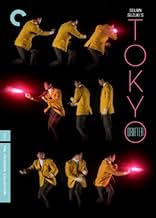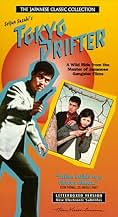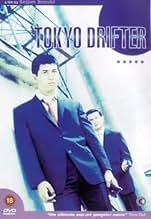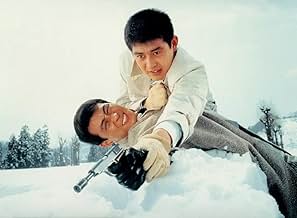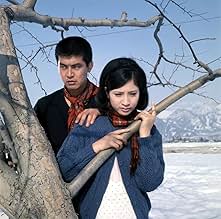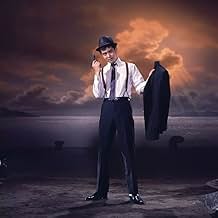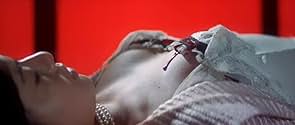NOTE IMDb
7,1/10
10 k
MA NOTE
Lorsque son clan est démantelé, un homme de main des yakuza espère pouvoir quitter le crime organisé, mais il devient vite un vagabond après que son ancien rival tente de l'assassiner.Lorsque son clan est démantelé, un homme de main des yakuza espère pouvoir quitter le crime organisé, mais il devient vite un vagabond après que son ancien rival tente de l'assassiner.Lorsque son clan est démantelé, un homme de main des yakuza espère pouvoir quitter le crime organisé, mais il devient vite un vagabond après que son ancien rival tente de l'assassiner.
- Réalisation
- Scénario
- Casting principal
Tamio Kawaji
- Tatsuzo, The Viper
- (as Tamio Kawachi)
Avis à la une
In my opinion, Tokyo Drifter is worth seeing, but comparing it to Branded to Kill is a bit like comparing apples and oranges.
Branded to Kill is eerie and nightmarishly weird--unforgettably, perhaps like a Hitchcock film or a dark film noire. Tokyo Drifter, on the other hand, is more "romantic." It is fun and chock full of mod 60s fashions and go-gos.
Both films are masterpieces of style. To me, Tokyo Drifter is worth seeing, but it has some silly moments. Somehow, I was left thinking of Woody Allen's What's Up Tiger Lilly and James Bond!
Branded to Kill is eerie and nightmarishly weird--unforgettably, perhaps like a Hitchcock film or a dark film noire. Tokyo Drifter, on the other hand, is more "romantic." It is fun and chock full of mod 60s fashions and go-gos.
Both films are masterpieces of style. To me, Tokyo Drifter is worth seeing, but it has some silly moments. Somehow, I was left thinking of Woody Allen's What's Up Tiger Lilly and James Bond!
If you are fed up by ordinary manufactured campiness, but still have normal levels of humor.. Which is to say if you find Austin Powers not only boring but trivial, you might check this out. It is high camp. It is ridiculous in ways that in other action films we readily accept: think the recent James Bonds. There is a joke product placement — for hair driers — that is really funny.
We have the ordinary sort of thing that qualifies: cheesy songs, goofy hero, posed action, jingly hipness. But we have a level of cheesiness that goes beyond the Tarrantino level, beyond the usual joke. The cinematography is one big joke, one that still works today because the big movies still use Vietnam era visual devices.
We have jokes on Bertralucci, Welles, Kurosawa. Leone of course. We have a couple stagings from Bergman even. It is not worth the effort to single out any Frenchman it seems, treating them with the contempt of wholesale dismissal.
Under ordinary circumstances, I would not recommend this because the usual level of the joke gets pretty tiring after 20-30 minutes. But the cinematic jokes and references keep coming, as though there were a catalogue (like we are told the Coen brothers keep). The blatant vacancy of the visuals is pretty damning.
Ted's Evaluation -- 2 of 3: Has some interesting elements.
We have the ordinary sort of thing that qualifies: cheesy songs, goofy hero, posed action, jingly hipness. But we have a level of cheesiness that goes beyond the Tarrantino level, beyond the usual joke. The cinematography is one big joke, one that still works today because the big movies still use Vietnam era visual devices.
We have jokes on Bertralucci, Welles, Kurosawa. Leone of course. We have a couple stagings from Bergman even. It is not worth the effort to single out any Frenchman it seems, treating them with the contempt of wholesale dismissal.
Under ordinary circumstances, I would not recommend this because the usual level of the joke gets pretty tiring after 20-30 minutes. But the cinematic jokes and references keep coming, as though there were a catalogue (like we are told the Coen brothers keep). The blatant vacancy of the visuals is pretty damning.
Ted's Evaluation -- 2 of 3: Has some interesting elements.
In 1966 Nikkatsu, a Japanese studio, requested that one of their more "difficult" directors "calm down" on his next project. The director was Seijun Suzuki. The project was Tokyo Drifter. The result was anything but calm.
A film-noir shot through with moments of brilliant, lurid colour; the film defies all conventions be it genre, style or even something as mundane and unnecessary as narrative. One scene finds Tetsuya Watari's pouting yakuza in a tense showdown with his rival. Standing on train tracks, surrounded by clean, crisp snow the screen is split in two by a clearly visible dark blue line. The use of this visual effect is telling. It adds nothing to the story, to the characterisation, it simply looks good.
The closing sequence has to be seen to be believed. It is best described as the secret lovechild of a Gene Kelly musical and a John Woo action film. Amazing.
If for nothing else, Tokyo Drifter will long be remembered for the theme tune which hauntingly drifts through the entire film.
A film-noir shot through with moments of brilliant, lurid colour; the film defies all conventions be it genre, style or even something as mundane and unnecessary as narrative. One scene finds Tetsuya Watari's pouting yakuza in a tense showdown with his rival. Standing on train tracks, surrounded by clean, crisp snow the screen is split in two by a clearly visible dark blue line. The use of this visual effect is telling. It adds nothing to the story, to the characterisation, it simply looks good.
The closing sequence has to be seen to be believed. It is best described as the secret lovechild of a Gene Kelly musical and a John Woo action film. Amazing.
If for nothing else, Tokyo Drifter will long be remembered for the theme tune which hauntingly drifts through the entire film.
"Tokyo Drifter" is my introduction to the cinematic work of director Seijun Suzuki and it made quite a big impression. This is by far one of the most visually unique movies I have ever seen and the fact that it was made in 1966 makes it even more impressive.
Tetsuya played by Tetsuya Watari is a yakuza who has joined his boss Kurato (Ryuji Kita) in going straight. Unfortunately for both of them a rival gang begins threatening Kurato's legitimate business. After a brief confrontation Tetsuya is forced to leave his boss that way he would hopefully relieve the pressure between Kurato and the gang. Things don't go as smoothly as Tetsuya planned and he finds himself chased by gangs all over Japan.
The story is standard fare yakuza tale. With a hefty doze of betrayal, inner power struggles and a bit of melodrama in the form of Tetsuya's girlfriend. We've seen it all before. Now. What really sets this movie apart from any other is it's unique visual nearly surrealistic style. Suziki employs several tricks in order to assure that the film will remain distant from any other. His use of colors creates one part of the that. More accurately his use of color contrast, we see that in several scenes through the movie, for example during the final shootout we see gang members dressed in primarily black suits while the location itself was in mainly white bright colors. Tetsuya himself is often dressed in colors that merge him with the backgrounds further helping in the creation of the film's extravagant look. The second aspect of the movie's uniqueness is the camera work and the overall directing. Suziki employs techniques that are reminiscene of western movies and more specifically Sergio Leone's line of work. The final shootout again serves as a great example of that.
The acting is on par with the script, characters are well played by their respective actors. They don't make an overly big impression but certainly don't deteriorate the quality. The film has a good music score with a particularly memorable theme song by the main actor Tetsuya Watari that is always nice to hear and fit's very well with the mood.
"Tokyo Drifter" is a movie that offers stunning visuals and a plot that while not very deep in characterization is still able to carry the film's unique style. Mister Suzuki is able to impress, sadly his production company at the time wasn't on the same opinion and soon after he was fired and blacklisted for 10 years. A real shame for a director with such talent.
Tetsuya played by Tetsuya Watari is a yakuza who has joined his boss Kurato (Ryuji Kita) in going straight. Unfortunately for both of them a rival gang begins threatening Kurato's legitimate business. After a brief confrontation Tetsuya is forced to leave his boss that way he would hopefully relieve the pressure between Kurato and the gang. Things don't go as smoothly as Tetsuya planned and he finds himself chased by gangs all over Japan.
The story is standard fare yakuza tale. With a hefty doze of betrayal, inner power struggles and a bit of melodrama in the form of Tetsuya's girlfriend. We've seen it all before. Now. What really sets this movie apart from any other is it's unique visual nearly surrealistic style. Suziki employs several tricks in order to assure that the film will remain distant from any other. His use of colors creates one part of the that. More accurately his use of color contrast, we see that in several scenes through the movie, for example during the final shootout we see gang members dressed in primarily black suits while the location itself was in mainly white bright colors. Tetsuya himself is often dressed in colors that merge him with the backgrounds further helping in the creation of the film's extravagant look. The second aspect of the movie's uniqueness is the camera work and the overall directing. Suziki employs techniques that are reminiscene of western movies and more specifically Sergio Leone's line of work. The final shootout again serves as a great example of that.
The acting is on par with the script, characters are well played by their respective actors. They don't make an overly big impression but certainly don't deteriorate the quality. The film has a good music score with a particularly memorable theme song by the main actor Tetsuya Watari that is always nice to hear and fit's very well with the mood.
"Tokyo Drifter" is a movie that offers stunning visuals and a plot that while not very deep in characterization is still able to carry the film's unique style. Mister Suzuki is able to impress, sadly his production company at the time wasn't on the same opinion and soon after he was fired and blacklisted for 10 years. A real shame for a director with such talent.
I will argue until my death that TOKYO DRIFTER is superior to BRANDED TO KILL, but that's for another time...
I am amazed every time I see this film that Suzuki could take such an obviously inferior product -- as Nikkatsu Studios was churning out at an obscene rate in those days, giving directors a script and saying "Shoot it fast and cheap so we can give you your next job" -- and turn it into one of the most beautiful and intriguing films I've ever seen.
Best plot ever? No. Easy to follow? Yes. Beautiful? Yes. And that theme...I could never forget that theme if I tried, even after my first viewing.
I'd ramble on about history and plot and so on, but so many others have, I'll just leave it at this: TOKYO DRIFTER makes me happy every time I see it.
I am amazed every time I see this film that Suzuki could take such an obviously inferior product -- as Nikkatsu Studios was churning out at an obscene rate in those days, giving directors a script and saying "Shoot it fast and cheap so we can give you your next job" -- and turn it into one of the most beautiful and intriguing films I've ever seen.
Best plot ever? No. Easy to follow? Yes. Beautiful? Yes. And that theme...I could never forget that theme if I tried, even after my first viewing.
I'd ramble on about history and plot and so on, but so many others have, I'll just leave it at this: TOKYO DRIFTER makes me happy every time I see it.
Le saviez-vous
- AnecdotesWas shot and edited in 28 days.
- Citations
Tetsuya 'Phoenix Tetsu' Hondo: A drifter needs no woman.
- ConnexionsFeatured in Seijun Suzuki | TCM (2013)
Meilleurs choix
Connectez-vous pour évaluer et suivre la liste de favoris afin de recevoir des recommandations personnalisées
- How long is Tokyo Drifter?Alimenté par Alexa
Détails
Box-office
- Montant brut mondial
- 755 $US
- Durée1 heure 29 minutes
- Couleur
- Mixage
- Rapport de forme
- 2.35 : 1
Contribuer à cette page
Suggérer une modification ou ajouter du contenu manquant


